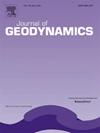外西阿尔卑斯(Pelvoux地块)上三叠统岩浆流(Spilite)的原位U-Pb定年:外围CAMP活动?
IF 2.1
3区 地球科学
Q2 GEOCHEMISTRY & GEOPHYSICS
引用次数: 0
摘要
三叠纪—侏罗纪过渡时期的岩浆活动与泛大陆的分裂相吻合,是西欧构造演化的关键时期。然而,这种活动在西阿尔卑斯山脉外部的记录很少。由于阿尔卑斯山碧岩等三叠纪岩浆岩的蚀变历史复杂,且缺乏合适的矿物相,因此对其侵位和蚀变定年一直具有挑战性。本研究采用碳酸盐原位U-Pb定年法对法国Pelvoux地块的碧岩热液蚀变进行了时间限制,为这些过程提供了一个新的时间框架。碧岩中白云石和方解石充填囊泡和脉体的生成年龄分别为201 ± 15 Ma和202 ± 47 Ma,与这些熔岩在上三叠统的地层侵位间隔一致。值得注意的是,白云岩中的U-Pb系统保留了与岩浆侵位相关的热液条件,在接近300°C的温度下,在随后的两次地质事件中没有重置,强调了其作为计时器的可靠性。所得年龄与中大西洋岩浆省(CAMP)的时间格架重叠,碧岩的地球化学特征对应于中/高钛向碱性玄武岩的过渡,与中大西洋岩浆省(CAMP)等大陆玄武岩相当。这表明它与幔源岩浆活动具有共同的构造-岩浆环境。此外,所研究的细碧岩与内阿尔卑斯山脉下地壳camp相关岩浆活动的空间接近性支持了一种潜在的成因关系,岩浆上升可能是由上三叠统伸展和阿尔卑斯特提斯山脉张开的继承构造促进的。热液蚀变发生在低温至中温条件下(70-360°C),可能是由海相或陆相流体驱动的。通过首次提供西阿尔卑斯山脉外部细碧岩的绝对地质年代学约束,本研究扩大了CAMP的公认范围。它强调了碳酸盐作为揭示热液和岩浆历史的可靠档案的效用。本文章由计算机程序翻译,如有差异,请以英文原文为准。
In situ U–Pb dating of upper triassic magmatic flows (Spilite) in the External Western Alps (Pelvoux massif): A peripheral CAMP activity?
Magmatic activity during the Triassic-Jurassic transition coincided with the breakup of Pangea, marking a pivotal period in Western European tectonic evolution. However, this activity remains poorly documented in the External Western Alps. Dating the emplacement and alteration of Triassic magmatic rocks such as the spilites in the Alps has long been challenging due to the complex alteration history and the scarcity of suitable mineral phases. This study employs in situ U-Pb dating of carbonate to constrain the timing of hydrothermal alteration of spilites from the Pelvoux massif (France), offering a new temporal framework for these processes. Dolomite and calcite filling vesicles and veins in the spilites yield ages of 201 ± 15 Ma and 202 ± 47 Ma, respectively, consistent with the stratigraphic emplacement interval of these lavas during the Upper Triassic. Notably, the U-Pb system in dolomite has preserved hydrothermal conditions related to magmatic emplacement, without resetting during two subsequent geological events at temperatures approaching 300°C, emphasizing its reliability as a chronometer in this context. The obtained ages overlap with the temporal framework of the Central Atlantic Magmatic Province (CAMP) and geochemical signatures of the spilites correspond to medium/high-Ti transitional to alkaline basalts, comparable to continental basalts such as those of the CAMP. This suggests a shared tectono-magmatic context with mantle-derived magmatism. Furthermore, the spatial proximity of the studied spilites to lower crustal CAMP-related magmatism in the Internal Alps supports a potential genetic relationship, with magma ascent likely facilitated by inherited tectonic structures during the Upper Triassic extension and the opening of the Alpine Tethys. Hydrothermal alteration, marked by spilitization and carbonate precipitation, occurred under low- to moderate-temperature conditions (70–360°C), possibly driven by marine or continental-derived fluids. By providing the first absolute geochronological constraints on spilites in the External Western Alps, this study expands the recognized extent of CAMP. It underscores the utility of carbonates as reliable archives for unraveling hydrothermal and magmatic histories.
求助全文
通过发布文献求助,成功后即可免费获取论文全文。
去求助
来源期刊

Journal of Geodynamics
地学-地球化学与地球物理
CiteScore
4.60
自引率
0.00%
发文量
21
审稿时长
6-12 weeks
期刊介绍:
The Journal of Geodynamics is an international and interdisciplinary forum for the publication of results and discussions of solid earth research in geodetic, geophysical, geological and geochemical geodynamics, with special emphasis on the large scale processes involved.
 求助内容:
求助内容: 应助结果提醒方式:
应助结果提醒方式:


